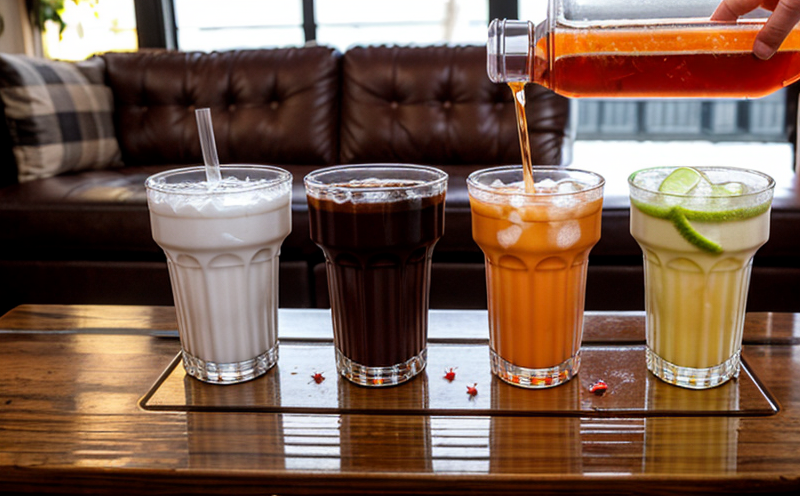ISO 20650 Vitamin E Analysis in Juice Products
The demand for high-quality, safe, and nutritious food products has never been greater. In the beverage sector, ensuring the accurate content of essential nutrients such as vitamin E is crucial to maintaining product integrity and compliance with international standards.
ISO 20650 specifies a method for determining tocopherols (vitamin E) in liquid beverages using high-performance liquid chromatography (HPLC). This method is particularly important because it ensures that the nutritional claims of juice products are accurate, thereby protecting consumer health and trust.
Vitamin E plays a vital role in preventing oxidative stress by neutralizing free radicals. In beverage testing, this method provides precise quantification of vitamin E content, which helps manufacturers maintain consistent quality across batches. This is especially important for companies that produce vitamin-enriched beverages or those targeting consumers concerned about their intake of essential nutrients.
The ISO 20650 standard ensures consistency and reliability in the analysis process by providing detailed procedural steps, including specimen preparation, chromatographic conditions, detection methods, and calibration procedures. This guarantees accurate results that can be relied upon for regulatory compliance and internal quality control.
Specimen preparation involves several critical steps, such as dilution of the beverage sample to ensure it falls within the linear range of the method. The sample is then injected into the HPLC system for analysis. Calibration standards are prepared using authentic vitamin E compounds or pure substances. These standards serve as reference points to calibrate the instrument and quantify the actual amount of vitamin E present in the specimen.
The instrumental setup typically includes a pre-column, column oven, detector, and data processing unit. The method uses an isocratic mobile phase with specific solvents and a UV detector set at 295 nm for optimal detection of tocopherols. The results are reported as milligrams per liter (mg/L) or parts per million (ppm).
Compliance with ISO 20650 ensures that beverage manufacturers can confidently claim the vitamin E content on their labels, which is essential for regulatory compliance and consumer trust.
In conclusion, ISO 20650 provides a robust framework for accurately measuring vitamin E in juice products. This method enhances product quality, supports regulatory requirements, and fosters consumer confidence by ensuring that nutritional claims are accurate and reliable.
Applied Standards
The analysis of tocopherols (vitamin E) in liquid beverages is governed primarily by ISO 20650. This standard provides a detailed protocol for sample preparation, chromatographic conditions, and detection methods to ensure accurate quantification.
- Sample Preparation: The beverage sample undergoes dilution if necessary to bring the concentration within the linear range of the HPLC method.
- HPLC Conditions: An isocratic mobile phase with specific solvents and a UV detector set at 295 nm for optimal detection.
- Detection Method: The use of a UV-visible spectrophotometer to measure the absorbance of tocopherols at 295 nm.
The calibration standards are prepared using authentic vitamin E compounds or pure substances, which serve as reference points for calibrating the instrument and quantifying the actual amount present in the specimen. This ensures that results are accurate and reliable.
Why Choose This Test
- Accurate Quantification: The method provides precise quantification of vitamin E content, which is essential for maintaining product quality and consistency across batches.
- Regulatory Compliance: ISO 20650 ensures that the analysis meets regulatory requirements, supporting compliance with international standards.
- Consumer Trust: Accurate nutritional labeling enhances consumer trust by ensuring that the claims made about vitamin E content are accurate and reliable.
- Quality Control: The method serves as a tool for internal quality control, allowing manufacturers to monitor the consistency of vitamin E content in their products.
The ISO 20650 method is widely recognized for its accuracy and reliability. It ensures that beverage manufacturers can confidently claim the vitamin E content on their labels, which is essential for regulatory compliance and consumer trust.
Customer Impact and Satisfaction
The ISO 20650 method has a significant impact on customers by ensuring that the vitamin E content in juice products is accurate and reliable. This, in turn, enhances customer satisfaction and trust.
- Informed Decision-Making: Consumers can make informed decisions about their dietary intake of vitamin E based on accurate labeling.
- Product Integrity: The method ensures that the product integrity is maintained by accurately quantifying vitamin E content, which supports regulatory compliance and internal quality control.
- Health Benefits: Accurate vitamin E content in beverages can provide health benefits to consumers who rely on these products for their nutritional needs.
The ISO 20650 method is a critical tool for manufacturers, ensuring that they meet regulatory requirements and maintain the quality of their products. This leads to higher customer satisfaction and trust, which are essential for long-term business success.





